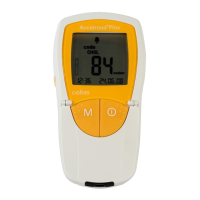Introduction
12
Test principle
By means of a code strip, the instrument reads the lot-specific characteristics of the test strips currently in use. This
information is stored and must therefore only be read once per test strip container. To run a test, an unused test
strip is taken from the container and inserted into the instrument. When inserted, the application area of the test
strip is illuminated by an LED (light-emitting diode) from below. Before sample application, the reflection behavior
of the test strip is determined by means of the light which is reflected from the application area (blank value).
The blood sample is then applied to the application area and the measurement chamber flap is closed. The
constituent to be determined in the applied sample undergoes an enzymatic reaction with formation of a dye. The
amount of dye formed increases with the concentration of the substance to be determined.
After a certain period of time (dependent on the test parameter), the color intensity is measured by illuminating the
application area again from below using the LED. The intensity of the reflected light is measured with a
detector (reflectance photometry). The measured value is determined from the signal strength of the reflected
light, using the previously measured blank value and the lot-specific information from the code strip. Finally, the
result is displayed and simultaneously stored in the memory.

